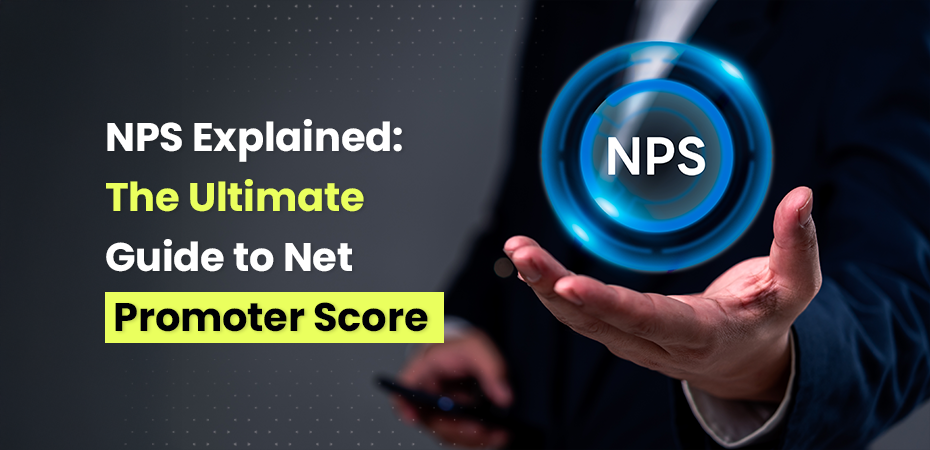NPS Explained: The Ultimate Guide to Net Promoter Score



Introduction
Customer loyalty and satisfaction are essential for business success, but how do you measure them effectively? That’s where the Net Promoter Score (NPS) comes in. NPS is a powerful metric used to gauge customer sentiment, helping businesses assess satisfaction levels and identify areas for improvement.
By asking a simple question—“How likely are you to recommend our business to others?”—NPS categorizes customers into Promoters, Passives, and Detractors. The Net Promoter Score is calculated to reflect overall customer perception.
Understanding your NPS allows you to make data-driven decisions, enhance customer experience, and build lasting relationships. A strong NPS strategy not only improves retention but also drives referrals and long-term growth.
In this guide, we’ll break down what NPS is, how it’s calculated, why it’s important, and how you can use it to refine your business strategy for better customer engagement and success.
Net Promoter Score (NPS)- Meaning and Calculation
NPS stands for Net Promoter Score, which is a widely used customer satisfaction metric that measures customer loyalty and their likelihood of recommending your business. Introduced by Fred Reichheld in 2003, NPS is based on a simple yet insightful survey question:
“On a scale of 0-10, how likely are you to recommend our company, product, or service to a friend or colleague?”
Customers provide a rating, which helps categorize them into three key groups:
How is to Calculate NPS?
To calculate Net Promoter Score, go through the following steps:
Categorizing Customers
- Promoters (9-10): These are your most loyal customers. They love your brand, actively recommend it, and contribute to positive word-of-mouth marketing.
- Passives (7-8): These customers are generally satisfied but not enthusiastic enough to promote your business. While they don’t harm your brand, they won’t actively advocate for it either.
- Detractors (0-6): These customers are unhappy and may spread negative feedback, potentially damaging your reputation.
The NPS Formula
Once customers are categorized, use this NPS (Net Promoter Score) formula:
NPS = % of Promoters – % of Detractors
For example, if 60% of respondents are Promoters and 20% are Detractors, your NPS would be:
60% – 20% = NPS of 40
A higher NPS indicates stronger consumer loyalty, helping businesses refine strategies for long-term success.
Why is NPS Important for Businesses?
A high Net Promoter Score (NPS) is a strong indicator of customer loyalty, which plays a crucial role in business success. Here’s why NPS matters:
- Predicts Business Growth: Companies with a high NPS often experience faster growth, as satisfied customers are more likely to make repeat purchases and refer others. Word-of-mouth recommendations from loyal customers can significantly boost revenue and brand reputation.
- Identifies Areas for Improvement: NPS provides direct insights into customer satisfaction. By analyzing feedback from Detractors, businesses can pinpoint weaknesses, address pain points, and refine their products or services to enhance the customer experience.
- Encourages Customer-Centric Strategies: A strong NPS encourages businesses to prioritize customer experience, leading to improved engagement, satisfaction, and long-term relationships. By consistently acting on customer feedback, companies can build trust and loyalty.
NPS isn’t just a number—it’s a strategic tool that helps businesses stay competitive by keeping customers at the center of their growth strategy. Regularly measuring and improving NPS can lead to higher retention rates, increased customer advocacy, and long-term success. Companies that actively listen to their customers and take action are more likely to thrive in today’s competitive market.
Understanding Promoters, Passives, and Detractors
Promoters (9-10)
These are your most loyal customers who actively recommend your business to others. They contribute to revenue growth, make repeat purchases, and engage positively with your brand. Their word-of-mouth marketing helps attract new customers.
Passives (7-8)
Passives are satisfied but not enthusiastic enough to promote your business. While they don’t harm your brand, they may easily switch to competitors if offered better deals or superior service. They need extra motivation to become loyal advocates.
Detractors (0-6)
Detractors are unhappy customers who may leave negative reviews or discourage others from choosing your brand. Their dissatisfaction can harm your reputation and customer trust. Addressing their concerns promptly can prevent churn and improve customer experience.
Understanding these three groups helps businesses refine strategies, boost retention, and turn more customers into Promoters for sustainable growth!
How to Use NPS Data Effectively
NPS isn’t just a number—it’s a powerful tool for understanding customer sentiment and making data-driven improvements. Here’s how to use it effectively:
- Gather Insights from Feedback: Don’t just collect scores—dive deeper! Ask follow-up questions to uncover customer pain points, expectations, and opportunities for improvement. Understanding why customers feel a certain way helps refine your offerings.
- Engage with Detractors: Dissatisfied customers pose a risk to your brand reputation. Reach out, listen to their concerns, and provide solutions. Turning Detractors into satisfied customers can increase retention and prevent negative word-of-mouth.
- Leverage Promoters: Happy customers are your best brand ambassadors. Encourage them to leave positive reviews, share testimonials, and refer others. A strong referral program can turn Promoters into a powerful marketing asset.
Best Practices for Improving Your NPS
Improving your Net Promoter Score (NPS) requires a strategic approach focused on enhancing customer satisfaction and loyalty. Here’s how to make the most of your NPS data:
- Enhance Customer Experience: A seamless, personalized experience is key to keeping customers engaged and happy. Proactive support, smooth interactions, and tailored recommendations can build trust and encourage repeat business. From quick response times to hassle-free transactions, every interaction should leave a positive impression.
- Train Employees: Your customer service teams play a vital role in shaping the customer experience. Ensure they’re well-trained in empathy, problem-solving, and active listening to handle concerns effectively. When employees genuinely care about resolving issues, customers are more likely to stay loyal.
- Use Automation Tools: Leverage CRM and customer feedback software like Salesforce to track NPS trends, identify patterns, and act on insights quickly. Automated follow-ups ensure concerns don’t go unnoticed, closing the feedback loop efficiently.
By using NPS data strategically, businesses can not only boost customer satisfaction but also strengthen brand loyalty and drive long-term growth. A well-executed NPS strategy turns satisfied customers into brand advocates who fuel business success.
Common Mistakes to Avoid When Measuring NPS
While Net Promoter Score (NPS) is a valuable tool for measuring customer loyalty, businesses often make mistakes that limit its impact. Here are key pitfalls to avoid:
- Ignoring Follow-Ups: Gathering NPS data is just the beginning. If you don’t act on customer feedback, you risk losing trust. Detractors need prompt attention to resolve concerns, while Passives may need a push to become loyal customers. Engaging Promoters can further strengthen their advocacy.
- Overlooking Passive Customers: Many businesses focus only on Promoters and Detractors, forgetting about Passives (7-8 scores). While they may seem content, they are more likely to switch to competitors if a better option arises. Personalized engagement, incentives, and targeted communication can convert them into loyal customers.
- Focusing Only on the Score: A high NPS is great, but it’s not enough. The real value lies in qualitative feedback—the reasons behind customer ratings. Customer comments highlight pain points, preferences, and areas for improvement, allowing businesses to make informed decisions.
By avoiding these mistakes and using NPS insights strategically, businesses can refine their approach, improve customer satisfaction, and build lasting brand loyalty.
NPS Benchmarks: What is a Good NPS Score?
Interpreting your NPS correctly is key to understanding customer sentiment. Here’s a general breakdown:
- Above 50: Excellent! Your customers love your brand, and word-of-mouth referrals are strong. Keep enhancing their experience.
- 30-50: Good. You have a solid base of satisfied customers, but there’s room for improvement in engagement and retention.
- 0-30: Average. Customer sentiment is mixed. Addressing feedback proactively can boost satisfaction and loyalty.
- Below 0: Needs Improvement. More Detractors than Promoters indicate serious concerns. Immediate action is needed to resolve issues and rebuild trust.
NPS benchmarks vary by industry—for instance, SaaS companies often score higher than service-based businesses. Comparing your NPS against industry standards helps set realistic goals for improvement.
Conclusion
Net Promoter Score (NPS) is more than just a metric—it’s a powerful tool that helps businesses strengthen customer relationships and drive long-term success. By actively listening to customer feedback and making data-driven improvements, you can enhance satisfaction, reduce churn, and foster brand loyalty.
A strong NPS strategy isn’t just about measuring scores; it’s about taking action to turn customers into loyal advocates. Engaging with Detractors, nurturing Passives, and leveraging Promoters can create sustainable business growth.
Want to refine your marketing strategy and boost customer engagement? Phoenix SEO Ninja, a trusted SEO service agency in Phoenix, can help optimize your digital presence and attract more loyal customers. From SEO strategies to conversion-driven marketing, we ensure your business stands out online.
Take your brand to the next level—partner with Phoenix SEO Ninja today!
Frequently Asked Questions (FAQs)
A good Net Promoter Score is typically above 50. However, industry benchmarks vary, so it’s essential to compare within your sector.
It’s recommended to measure NPS quarterly or bi-annually to track customer sentiment trends effectively.
Yes, addressing customer concerns, enhancing service quality, and actively engaging with feedback can lead to an improved NPS over time.
Industries like SaaS, retail, hospitality, and financial services often rely on NPS to assess and enhance customer satisfaction.
Popular tools include SurveyMonkey, Qualtrics, HubSpot, and Medallia, which provide in-depth insights into NPS trends.